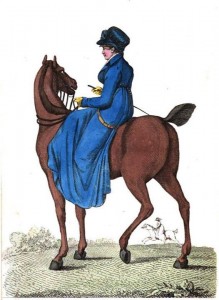 Sometimes, staying true to the Regency era can create some problems, yet further research almost always provides fun answers. While writing my Regency Romance, The Guise of a Gentleman, my Regency lady grabbed her gun and faced down a group of bad guys. I knew if she were to defend the man and boy in danger, she’d only be able to get off one shot because of the time and difficulty reloading guns in that era. I considered either having her ride with two loaded guns or have a groom with her but I wasn’t crazy about either option.
Sometimes, staying true to the Regency era can create some problems, yet further research almost always provides fun answers. While writing my Regency Romance, The Guise of a Gentleman, my Regency lady grabbed her gun and faced down a group of bad guys. I knew if she were to defend the man and boy in danger, she’d only be able to get off one shot because of the time and difficulty reloading guns in that era. I considered either having her ride with two loaded guns or have a groom with her but I wasn’t crazy about either option.
Then, I found just what I needed: existence of a double-barrel flintlock which could fire two shots using two different triggers. Huzzah!!!
Some rifles also had a side-by-side barrel, like a double-barreled shotgun. Like the shotgun, this type of weapon has two hammers, though it’s hard to see the second one behind the first in most photos. It also has two triggers, one for each barrel. I found a .54 cal. with the damascus barrel measuring nine inches long and weighing close to three pounds. Unusual for its day, the double-barrel configuration provided a decided advantage over its single-barreled counterpart, given the notoriously slow reloading procedure for flintlocks. The barrel is generally about eight inches long and it weighs about 2 pounds.
Most Flintlock pistols measured between 10 to 16 inches long, from butt to barrel muzzle. They weighed from one to four pounds, depending on the caliber and the number of barrels. There were a number of styles of double-barreled pistols during the Regency, but they were generally big and heavy. There were two types, the over and under, with a revolving lower barrel, but only one hammer, so that the pan had to be primed before firing again.
Ladies’ pistols were generally six to eight inches long–too small to hold a ramrod. A bullet for such a small gun would be no wider than this: / / roughly the size of today’s ammo for a BB gun. Ladies’ pistols weighed between 12 oz to one and a half pounds. The problem was that the flint, amount of powder, and mechanisms has to be smaller, which made firing them successfully more difficult.
Even though ladies’ pistols and double-barreled pistols look different, they were loaded the same way as all flintlocks. Most all flintlocks were smoothbores. Some were rifles, with spiral rifling in the barrels. They were difficult to load because the bullet had to be seated against the rifling grooves to spin the ball, so it was hard to ram home. Using cloth or leather wrapped around the ball made it easier to get down the barrel.
In the early 1800s, guns were hand made, and could be customized to fit the buyer’s specifications, so there were almost limitless options.
Note: I tried to add photos to this blog, but couldn’t find any that I was certain weren’t copyrighted. If you go to your browser and type in: “18th century black powder flintlock” or “18th century black powder ladies’ guns” you will find some beautiful images, mostly from places that have them to sell.
19th Century Firearms posted first on http://donnahatch.blogspot.com/
No comments:
Post a Comment